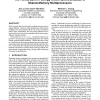Free Online Productivity Tools
i2Speak
i2Symbol
i2OCR
iTex2Img
iWeb2Print
iWeb2Shot
i2Type
iPdf2Split
iPdf2Merge
i2Bopomofo
i2Arabic
i2Style
i2Image
i2PDF
iLatex2Rtf
Sci2ools
HPCA
2004
IEEE
2004
IEEE
The Thrifty Barrier: Energy-Aware Synchronization in Shared-Memory Multiprocessors
Much research has been devoted to making microprocessors energy-efficient. However, little attention has been paid to multiprocessor environments where, due to the co-operative nature of the computation, the most energy-efficient execution in each processor may not translate into the most energyefficient overall execution. We present the thrifty barrier, a hardware-software approach to saving energy in parallel applications that exhibit barrier synchronization imbalance. Threads that arrive early to a thrifty barrier pick among existing low-power processor sleep states based on predicted barrier stall time and other factors. We leverage the coherence protocol and propose small hardware extensions to achieve timely wake-up of these dormant threads, maximizing energy savings while minimizing the impact on performance.
Barrier Stall Time | Barrier Synchronization Imbalance | Computer Architecture | HPCA 2004 | Thrifty Barrier Pick |
| Added | 01 Dec 2009 |
| Updated | 01 Dec 2009 |
| Type | Conference |
| Year | 2004 |
| Where | HPCA |
| Authors | Jian Li, José F. Martínez, Michael C. Huang |
Comments (0)

